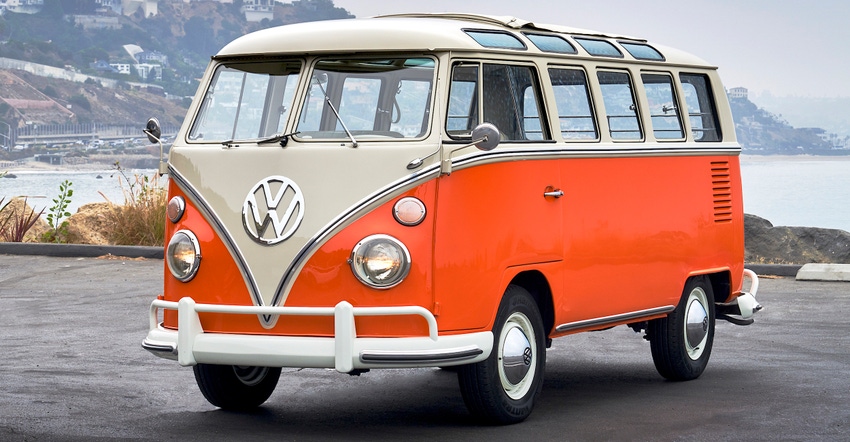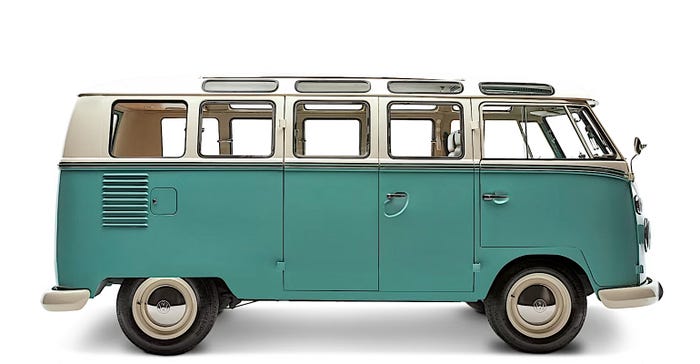Building Brand New Classic VW Buses Is Harder Than It Looks
Classic Steel creates all-new Volkswagen bus bodies for modernized vintage rides.

While we are familiar with the engineering work that goes into building new vehicles, it might be less obvious that significant engineering also goes into remaking old ones.
That’s the case at Classic Steel, an Ohio company that specializes in providing new sheetmetal for vintage Volkswagen models, especially for the classic first-generation VW bus.
A key challenge is to gather accurate dimensional data on each of the panels because the original specifications aren’t available and the existing machines have distorted so much over their six-decade lives that no two are the same and none of them is a reliable representative of the type, reports Mark Bowman, president of Classic Steel Body.
The company doesn’t only make replacement parts to repair old vans; they also produce complete body panel sets and assembles them into new bodyshells to create all-new vans. Such a body shell costs $30,000, but compared to the prices of nice Volkswagen vans or to the cost of restoring rusty ones, such a price can still look attractive to VW bus fans.
Classic Steel begins the process by scanning the outside of the part they aim to recreate. “Then you have to cut it up and scan the inside to create a 3D scan,” said Bowman. When Bowman started making classic VW parts, the 3D scans required $20,000 machines that were operated by specialists, but today he can scan most parts in his own shop using more affordable scanning tools.
Complicated parts can take as long as three years to go from scanning them to getting the final parts back from the stamping contractor in Taiwan, said Bowman. The average part takes about a year.
Following the part scan, Classic Steel makes its own examples of the parts. When it has two suitable examples, it sends them to GT Stampings in Taiwan, which is the company that also provides replacement parts for companies that specialize in other vehicles like Ford Broncos and Mustangs.
Remembering Classic VW Beetles
Creating a VW bus requires 101 separate pieces compared to only 38 pieces for a classic Bronco, so the bus takes a lot more time and effort to assemble in addition to needing more stampings.
GT Stampings creates production examples and returns them to Classic Steel for approval. “We try to fit them to a bus and sometimes they will be too long or have a mounting tab in the wrong place,” Bowman explained. Classic Steel informs GT Stampings of the necessary adjustments and gets another round of sample parts. Sometimes these parts fit, “but sometimes they send the part back and something different is wrong,” he said.
Eventually, the two sides hash it out and Classic Steel gets correct parts to provide customers. Then customers might complain that the parts don’t fit their old van if they haven’t ordered an all-new body shell.

That’s because the bodies on the old vans have sagged as surely as those of their drivers during the intervening decades, Bowman points out. “People believe that however their bus is, is how it should be,” he said. “Your bus has been flexing for 50 years.” Not only that, but buses came from the German and Brazilian plants that might have had their own variations when new.
Bowman said that Classic Steel would like to eliminate some of the back-and-forth process by sourcing stampings in the U.S. Some aspects of this notion are practical, but other aspects simply don’t pencil out, he said.
“We are working to have some more of our parts to be pressed in the U.S.,” Bowman explained. But the initial process to design and build the dies to stamp parts is prohibitively costly in the U.S. “It is five times as expensive to have one built over here,” he said. “It is $50,000 in the U.S. versus $10,000 in Taiwan.

However, at that point, Custom Steel owns the dies and can use them where they choose. “There are plenty of people who own presses,” he observed.
So for some parts at least, it could pay off to stamp them in the U.S., which is also more costly than stamping them in Taiwan. “I don’t have to ship it, so I don’t have to worry about ocean freight and customs,” Bowman said. “To just eliminate those allows you to pay a little more for the stampings. But we’d never be able to pay for the building of the stamps and the design work here initially.”
So if the new ID.Buzz EV isn’t exactly what you’re looking for in a retro VW bus, there’s the option of an all-new old one built on a Classic Steel body. These typically cost about $80,000 complete and are usually powered by electric motors or modern, water-cooled, fuel-injected Subaru flat-four-cylinder engines rather than old air-cooled VW units, he said. Either way, you’ll be rolling in style, surrounded by all-new steel sheetmetal in a classic design.
About the Author(s)
You May Also Like





